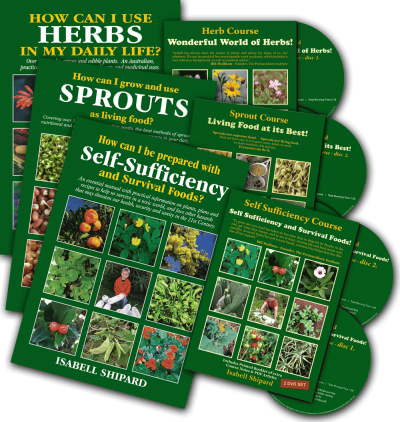Horseradish Tree, Marango Tree, Murunga, Kelor, Shobhanjan, Ben Tree, Moringa Tree
Moringa oleifera syn. M. pterygosperma F. Moringaceae
Description
A handsome, multi-purpose, small legume tree, 3-8 metres tall, fast growing and drought hardy, with a shady, leaf canopy of very attractive tripinnate ferny foliage, making its presence appealing wherever it is planted. Small, waxy, creamy-white flowers resembling miniature orchids, form in clusters on terminal stems, followed by 20-30cm long round pods. Pods look very much like drumsticks, a good reason for the plant’s common name. The shell of the pod splits into 3 sections revealing a row of neatly packed, wing-edged, round, brown seeds.
… … omitted text, please see How can I use HERBS in my daily life? for full text.

Medicinal Uses
A folk remedy for stomach complaints, catarrh, cancer, gastric ulcers, skin diseases, lowering blood sugar, increasing bone density, nervous conditions, diabetes, fatigue, increase lactation, hay fever, impotence, edema, cramps, hemorrhoids, headaches, sore gums; to strengthen the eyes and the brain, liver, gall, digestive, respiratory and immune system, and as a blood cleanser and blood builder. A traditional folk remedy was to use the leaves as a poultice on the abdomen to expel intestinal worms. An infusion of leaves is used as an eye wash for treating conjunctivitis. Oil from the seed, called Oil of Ben, is used for earache and in ointments for skin conditions. The oil rubbed on the skin is said to prevent mosquitoes from biting. Flowers infused in honey are used as a cough remedy.
Culinary Uses
Research has shown the drumstick tree to be of exceptional nutritional value. The leaves are 38% protein with the 8 essential amino acids, which will be of interest to vegetarians, or people who wish to cut back on meat and dairy products. Amino acids in leaves, indicated in milligrams per 100 grams have been recorded as: isoleucine 385, leucine 688, lysine 476, methionine 164, cystine 148, phenylalamine 483, threonine 368, valine 491, arganine 491, histidine 181.
Amino acids in green leaf vegetables vary considerably, and many that are staples, are low in the sulphur bearing amino acids methionine and cystine, whereas in the drumstick tree it is an extremely rich source in comparison to other greens and vegetables. The drumstick tree is listed as the highest protein ratio of any plant on earth. The calcium content is very high at 297mg per 100g of leaves.
Leaves can be eaten fresh in hand, steamed, pickled, added to salads, stir-fries, curries, and soups. Flavour of the pods are similar to peas with a mild mustard taste. Sliced, young green pods can be used in savory and meat dishes. Seeds can be fried or roasted and taste like peanuts. When seeds are abundant they can be sprouted like wheat grass, eaten as tender nutritious greens.
Roots of young seedlings taste similar to the herb horseradish, and are often grated and used as a substitute. Oil of Ben, a by-product of the seed, is an inodorous finegrade oil used in salads, cooking, perfumery, lubricating watches and fine machinery. The oil does not go rancid. Flowers can be eaten or used as a garnish, and look most decorative in salads. Value the tree for its high nutritional value and as a survival food.
… … omitted text, please see How can I use HERBS in my daily life? for full text.


